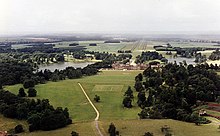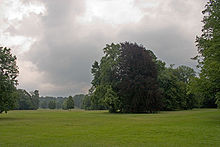English landscape garden
The English landscape garden (also English landscape park , English garden or English park for short ) is a landscape garden (landscape park), the shape and style of which developed in England in the 18th century. Within the history of garden art , it emerged as a deliberate contrast to the previously dominant French-style baroque garden , which forced nature into geometrically exact forms.
features

In contrast to the French-style baroque gardens with their large, geometrically laid out flower beds ( parterres ), there are hardly any flowering plants in the classic English landscape gardens. The idea of the English garden was to eliminate the previously existing mathematical rigor of the precisely laid out beds and trimmed hedges and to orientate the garden design more towards what nature ideally has to offer in terms of views. It was supposed to reflect the principle of a natural landscape , which should bring pleasure to the beholder's eyes through different and varied impressions in the sense of the ideal of a "walk-in landscape painting". Despite a desired “naturalness”, an English garden is a work of art that is based on the aesthetics of a landscape painting of ideal landscape painting , artists such as Claude Lorrain , Nicolas Poussin and Gaspard Dughet were decisive . In this sense, landscape gardens offer “picturesque” views. The creation of such a park landscape in Great Britain was also due to the intensive grazing in the vicinity of the early industrialization there .
The English landscape gardens are separated from the surrounding landscape by ditches that are invisible from a distance or sunken walls, known as ha-ha . The English landscape architect William Kent used the Ha-Ha as an invisible design element in his spacious garden plans. This was first introduced into garden design by Charles Bridgeman . It is a ditch that separates the actual garden from the adjoining landscape without seeing a transition. In this way, the nearby garden was visually merged into a single unit with the landscape further back, without larger fences, walls and hedges disturbing the view.
To accentuate the horizon , ancient temples , later also Chinese pagodas , artificial ruins , grottos and hermitages (hermitages) were placed in the landscape. An early model for original staffage buildings is the Mannerist Park of the Sacro Bosco in central Italy, created between 1552 and 1585, which in turn was based on ancient models such as the Villa Adriana , which also inspired the Renaissance and Baroque gardens. Instead of straight canals, round basins and cascades , which one could admire in the baroque garden from the geometrically precisely laid out paths, there were varied paths and rivers winding through the landscape in the English garden. Lancelot "Capability" Brown created gardens (or rather parks) with wide lawns, lavishly winding paths, freely winding rivers and natural-looking ponds and lakes, between which rows of suitable trees or smaller forests were planted. Often the paths were also built slightly sunk so that they could not be seen from the side from other paths and looked like undisturbed lawns. This free implementation of nature in the garden had a long tradition , especially in Japanese gardens , since the 8th century.
A phenomenon of the 18th and early 19th centuries were the decorative hermits , professional hermits who lived in specially arranged hermitages for a contractually agreed period and who showed up at certain times of the day in order to entertain the owners of the parks and their guests with their sight. Towards the end of the 18th century, Neo-Gothic buildings also came into fashion, under the influence of Horace Walpole , who also wrote a book on English gardening (Essays on Gardening 1794).
The idea of the English garden was also imported into neighboring countries in a modified form. Examples from Germany are the English Garden in Munich designed by Friedrich Ludwig Sckell and the Rombergpark in Dortmund or the Georgengarten and the Hinübersche Garden in Hanover . Christian Cay Lorenz Hirschfeld , whose theory of garden art appeared in five volumes between 1779 and 1785, led the introduction in Germany . He influenced, for example, Carl Heinrich August Graf von Lindenau (1755–1842), whose park in Machern is one of the earliest English gardens in Germany, even if certain ideas still go back to the garden ideals of sensitivity . The further development of landscape architecture on the European continent owes much to the “garden prince” Hermann von Pückler-Muskau .
Examples of landscaped gardens
Germany

- Von-Halfern-Park in Aachen
- Lousberg Park in Aachen
- Müschpark in Aachen
- Schönbusch Park in Aschaffenburg
- Altenstein Castle Park in Bad Liebenstein
- Fürst-Pückler-Park Bad Muskau
- Old spa park in Bad Soden am Taunus
- Lichtentaler Allee in Baden-Baden
- Princely camp near Bensheim (South Hesse)
- Biebrich Castle Park in Wiesbaden
- Bürgerpark in Bremen
- Wilhelmsthal Castle near Calden
- Bladenhorst Castle Park in Castrop-Rauxel
- The Hofgarten in Coburg
- Fürst-Pückler-Park Branitz in Cottbus
- Prinz-Emil-Garten in Darmstadt - Bessungen
- Dennenlohe landscape park
- Dessau-Wörlitz Garden Realm :
- Palace garden in Detmold
- English forest in Dischingen
- Rombergpark in Dortmund
- Seifersdorfer Tal near Dresden
- Hofgarten in Düsseldorf
- Eichstätt Court Garden
- Castle park in Eutin
- Lenné Park with Rose Island in Feldafing on Lake Starnberg
- Gotha Castle Park
- Princely Greizer Park
- Althaldensleben-Hundisburg Landscape Park in Haldensleben
- Wilhelmsbad ( Hanau )
- Georgengarten (Hanover)
- Welfengarten in Hanover
- Ernst Ehrlicher Park in Hildesheim
- Castle garden in Hohenzieritz
- Park and Dyck Castle in Jüchen
- Palace garden in Karlsruhe
- Bergpark Wilhelmshöhe in Kassel
- Karlsaue in Kassel
- English garden in Landsberg am Lech
- Evenburger Park in Leer - Loga
- Lütetsburg Castle Park
- Machern Palace Park near Leipzig
- Former castle park in March- Hugstetten
- Eulbacher Park near Michelstadt
- English garden in Meiningen
- English Garden in Munich
- Nymphenburg Palace Park in Munich
- Nennhausen Castle Park in Nennhausen
- English garden in Neuburg an der Donau
- Castle garden in Oldenburg
- Castle park of Castle Börln near Oschatz
- Park of Ostrau Castle near Halle
- Berlin-Potsdam cultural landscape with the facilities:
- Dörnbergpark in Regensburg
- German-French garden in Saarbrücken
- Ringelheim Castle Park in Salzgitter
- Castle park in Sayn
- Park of the Villa Haas property , Sinn in the Lahn-Dill district
- Sondershausen Castle Park
- Steinfurter Bagno
- Rosenstein Park in Stuttgart
- Castle park (now part of the city park) in Teublitz
- Queen Auguste Victoria Park in Umkirch
- Green Fields Park near Waldenburg (Saxony)
- Tiefurt near Weimar
- Park on the Ilm in Weimar
- Park Ettersburg near Weimar
- Park Belvedere near Weimar
- Castle park in Werneck
- Sanspareil rock garden in Wonsees
- Ringpark in Würzburg
Austria
Switzerland
- Ermitage Arlesheim
- Jardin Anglais in Geneva
- Park of Landshut Castle in Utzenstorf
- Park of the Villa Patumbah in Zurich
- Old Botanical Garden Zurich
England

- Blenheim Palace (by Capability Brown )
- Chiswick House
- Claremont House (by William Kent )
- The Leasowes
- Prior Park near Bath
- Stowe House (by William Kent)
- Stourhead
- Strawberry Hill
- Studley Royal Water Garden (by John Vanbrugh )
- Twickenham , the garden that was laid out for the poet Alexander Pope , is no longer preserved
- Wilton House
France

- Jardin des Plantes in Angers
- English garden in the Jardin Albert Kahn in Boulogne-Billancourt
- Jardin Monstrelet in Cambrai
- English garden in Chantilly Castle
- Jardin Lecoq in Clermont-Ferrand
- City garden Cognac
- English garden in Compiègne Castle
- English garden in Dinan
- Parc Bertin in Douai
- Ermenonville Park
- English garden in Fontainebleau Castle
- Park in Fontaine-Henry Castle
- Jardin botanique de Haute-Bretagne in Le Châtellier
- Parc de la Tete d'Or in Lyon
- Méréville Castle Park
- Parc Monceau and Parc Montsouris in Paris
- Parc Beaumont in Pau
- Park of the Bois-Préau castle in Rueil-Malmaison
- Jardin de la Rhônelle in Valenciennes
- English garden of the Petit Trianon in Versailles
- English garden of Vesoul
Poland
- Garden in Arkadia , district Łowicz , Lodz Province
- Buchwald (Bukowiec) in the Hirschberg Valley (Lower Silesia)
- Puławy (garden)
Russia
Sweden
Slovakia
Czech Republic
- Lednice (German: Eisgrub) and Valtice (German: Feldberg) in South Moravia , the largest landscape park in Europe and " UNESCO - World Heritage "
- Park of the Krásný Dvůr Castle (Schönhof)
- Buchlovice Castle
literature
sorted alphabetically by author
- Julia Berger, Uta Hassler, Kilian Jost: Constructed mountain experiences - waterfalls, alpine scenery, illuminated nature . Hirmer, Munich 2015, ISBN 978-3-7774-2579-5
- Julia Burbulla: The Principle of Life. Nature and science in the early landscape garden in Germany. In: The garden art . Vol. 21, No. 1, 2009, pp. 99-116.
- Adrian von Buttlar : The landscape garden. Garden art of classicism and romanticism. DuMont, Cologne 1989, ISBN 3-7701-2088-4 .
- Günter Hartmann: The ruin in the landscape garden. Their significance for early historicism and romantic landscape painting (= Green Series. 3). Wernersche Verlagsgesellschaft, Worms 1981, ISBN 3-88462-007-X (at the same time: Bochum, University, dissertation, 1980).
- Alfred Hoffmann: The landscape garden (= history of German garden art. Vol. 3). Broschek, Hamburg 1963, (Reprint: Koeltz, Königstein 1981, ISBN 3-87429-196-0 .
- Kilian Jost: Rock landscapes - a building task of the 19th century. Grottoes, waterfalls and rocks in landscaped gardens. Dissertation, Zurich 2015, ISBN 978-3-00-053146-0 .
- Heinz-Joachim Müllenbrock: The English landscape garden of the 18th century and its literary context. As a public lecture of the Joachim-Jungius-Gesellschaft der Wissenschaften held on November 5th, 1985 in Hamburg (= publication of the Joachim-Jungius-Gesellschaft der Wissenschaften. 54). Vandenhoeck & Ruprecht, Göttingen 1986, ISBN 3-525-86219-9 .
- Eduard Petzold : Prince Hermann von Pückler-Muskau in his work in Muskau and Branitz, as well as in his importance for the visual garden art in Germany. A biographical sketch resulting from personal and correspondence with the prince. Weber, Leipzig 1874.
- Andrea Siegmund: The landscape garden as a counterworld. A contribution to the theory of the landscape in the field of tension between Enlightenment, sensitivity, romanticism and counter-Enlightenment. Königshausen & Neumann, Würzburg 2011, ISBN 978-3-8260-4612-4 (also: Munich, Technical University, dissertation, 2010).
- Andrea Siegmund: The romantic ruin in the landscape garden. A contribution to the relationship between Romanticism and Baroque and Classical periods (= Foundation for Romantic Research. 22). Königshausen & Neumann, Würzburg 2002, ISBN 3-8260-2347-1 (also: Munich, Technical University, diploma thesis, 1999).
- Andrea Siegmund: Four types of ideal landscape or games with a tetrahedron. In: Laufen special contributions. 1, 2011, ISSN 1863-6446 , pp. 14-17.
- Andrea Siegmund: The ambiguity of the images in the landscape garden. In: Thomas Kirchhoff, Ludwig Trepl (ed.): Ambiguous nature. Landscape, wilderness and ecosystem as cultural-historical phenomena. transcript, Bielefeld 2009, ISBN 978-3-89942-944-2 , pp. 163-177.
- Frank Maier-Solgk, Andreas Greuter: Landscape gardens in Germany. Deutsche Verlags-Anstalt, Stuttgart 1997, ISBN 3-421-03143-6 .
- Ana-Stanca Tabarasi: The landscape garden as a model of life. On the symbolism of the “garden revolution” in Europe. Königshausen & Neumann, Würzburg 2007, ISBN 978-3-8260-3753-5 .
- Kerstin Walter: The picturesque. The theory of the English landscape garden as a building block for understanding contemporary art (= Benrath writings. 2). Wernersche Verlagsgesellschaft, Worms 2006, ISBN 3-88462-236-6 (also: Bochum, University, dissertation, 2004).
Web links
- English gardens of the 18th century - Arcadia is discovered
- The landscape garden (English Garden) - a brief overview (PDF file; 56 kB)
Individual evidence
- ^ Adrian von Buttlar: The landscape garden. Garden art of classicism and romanticism. DuMont, Cologne 1989, ISBN 3-7701-2088-4 .
- ↑ Wolfgang Diez, Helmut Röttig: Sondershausen. Pictures and stories; Declaration of love to a city. Image archive Röttig, Sondershausen 2000.
- ↑ Website for the Green Fields Park







